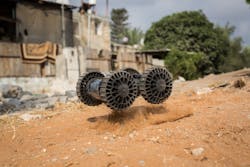Contributed: UGV Technology and it’s Future in the Law Enforcement Community
Contributed By Shahar Abuhazira, CEO of Roboteam
Law enforcement and military users are increasingly relying upon technology that save lives and provide more certainty in unknown environments. One tool that is being used to enhance human abilities and protect against modern day threats are unmanned ground vehicles (UGV). These robotic tools are proving useful across several fields of law enforcement and will likely become a vital piece of equipment over the next decade.
Unmanned ground vehicles increase the safe separation between the human operator and a particular hazard – whether the hazard is an IED, a terrorist in a building, or a chemical/radiological hazard. As first responder technology evolves (sensors, etc.) and robots become more capable, law enforcement will begin to take further advantage of integrating this technology into their emergency response strategy.
The most common UGV use-case for law enforcement is within bomb disposal units, followed by SWAT-type units. Explosive Ordnance Disposal units are using UGVs to conduct reconnaissance missions, confirmation and render safe activity. SWAT-type units are using UGVs to facilitate negotiations and perform surveillance. In addition, HAZMAT teams are also beginning to take note of UGVs and are requesting them in their units. As a result of ever increasing technological innovation in both payloads and robotics, we will see UGVs being used more broadly.
For instance, the evolution of increasingly smaller chemical and radiological sensors, as well as adoption of plug-and-play integration (of newer systems) means that users can more easily (and cost effectively) mount new sensors and parts to UGVs. Presently, HAZMAT units must wear special Personal Protective Equipment (PPE) and venture into known, or potentially, hazardous areas to conduct contamination surveys, etc. Technology now allows for UGVs to conduct a significant portion of these missions without humans being placed at risk and, in the long-term, HAZMAT units will begin to use UGVs wherever they can.
This past July, a robot was used by law enforcement to transport an explosive charge and kill an active shooter in Dallas. The robot was employed in part to communicate with the suspect, though it was equipped to incapacitate or kill the suspect as a last resort. In the case of the Dallas shooter, he refused to surrender after repeated attempts to negotiate, and upon determining there were no innocent bystanders, law enforcement decided to use the explosives attached to the robot.
The examples above show how technology enabled law enforcement to keep human lives out of dangerous environments and situations, permitting law enforcement and rescue workers to more safely and effectively save lives. At some point UGV technology will evolve to routine tasks that can be transferred to robotic systems, freeing more humans for more critical tasks. We could likely see departments using robots to monitor parked cars and issuing parking tickets.
While UGVs are very useful to police forces there is a fiscal restraint. Law enforcement agencies have the need for this technology, but lack the budget for a $60k system (which is at the low end of the cost scale). Law enforcement often needs to prioritize between necessity and contingency, and robots normally fall within the contingency category thusly diverting the funds to more immediate needs such as acquiring or fixing patrol cars. While police forces need to remain cognizant of militarization, there is legitimate potential for “retired” military UGVs to be moved to the law enforcement community.
Overall, in the coming decades competition will push the market toward less expensive UGV systems. This is where law enforcement will see the most benefit considering that budgetary constraints are the biggest inhibitor to broad incorporation. As legislation develops and competition among UGV providers increases we will begin to see a larger-scale adoption of UGV systems.
Shahar Abuhazira is CEO at Roboteam, a global leader in the design, development, and manufacture of cutting edge, user-oriented, multi-purpose, unmanned ground vehicles and controllers for defense, law enforcement and public safety missions.
